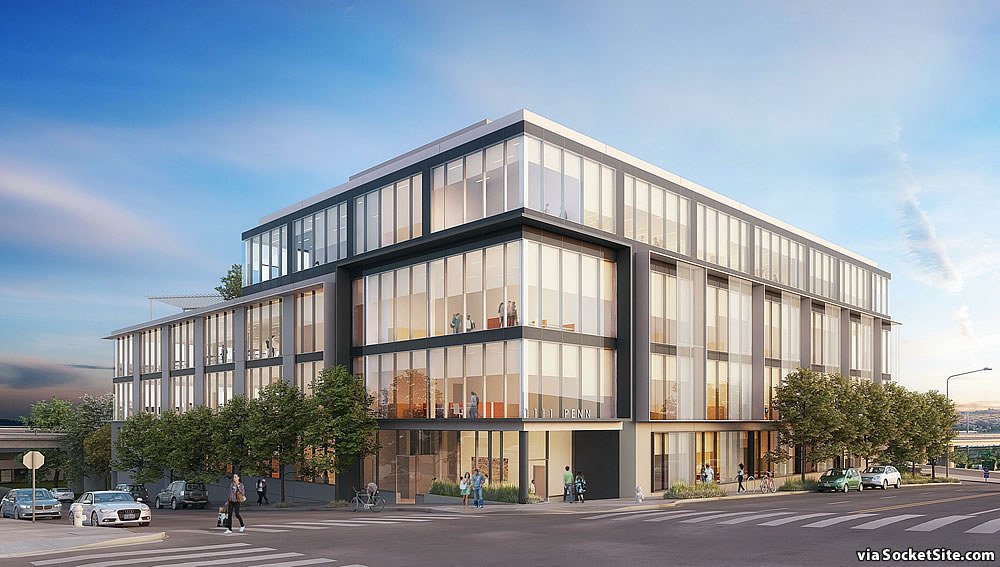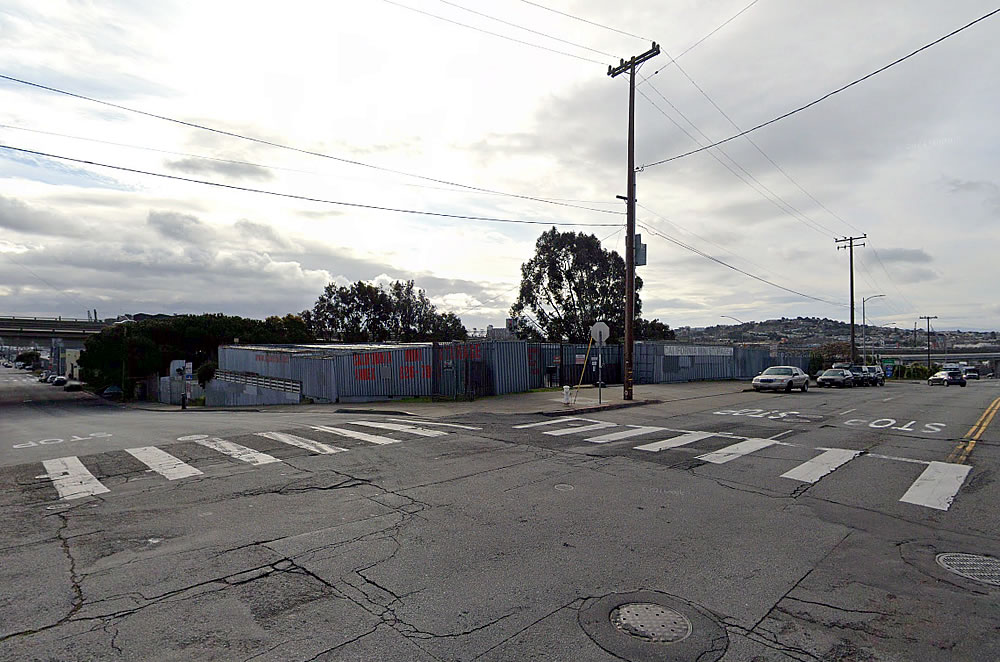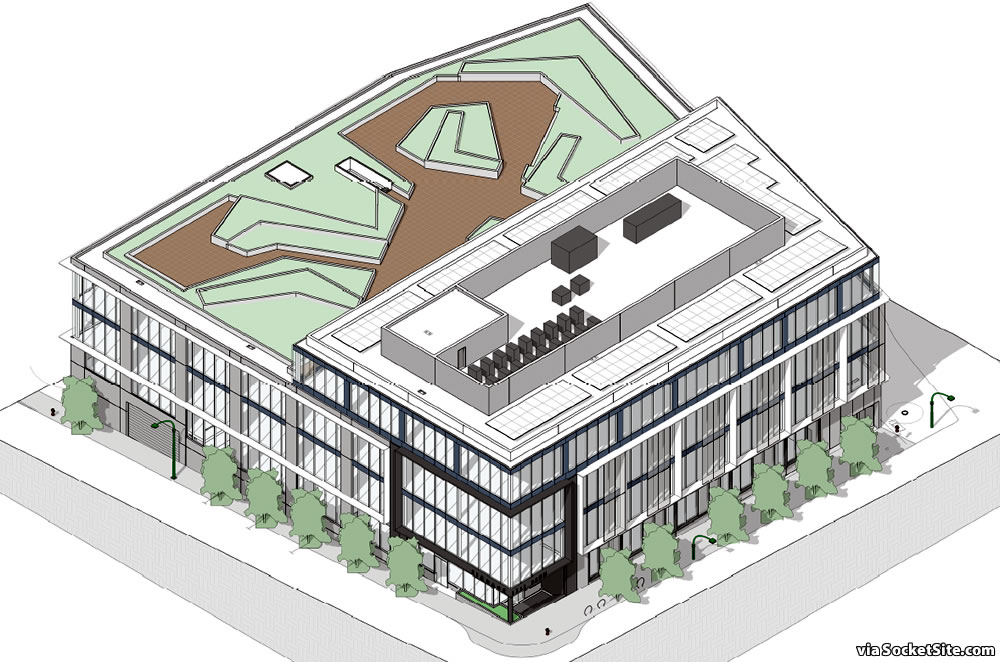Plans to disassemble, remove and otherwise demolish the California Mini Storage shipping container site at 1111 Pennsylvania Avenue are in the works. And as designed and newly refined by Workshop1, a 4-story building could rise up to 65 feet in height across the site, which is zoned for Production, Distribution and Repair (PDR) uses, at the base of Potrero Hill.
The development as proposed would yield 144,000 square feet of non-life sciences laboratory, testing, research and accessory office space, with a two-level basement garage for 20 cars and 56 bikes and a 16,800-square-foot rooftop terrace to the east.
And the project, which would take around two years to complete, has just been granted a Preliminary Mitigated Negative Declaration with respect to its potential environmental impacts, which is a good thing if you’re the developer and obviates the need for a lengthy environmental review. Permits for the project have been requested as well.



Are the lab buildings now officially the most profitable way of creating a loophole for the PDR limitations in these developments?
That said, it’s a nice building making a better use of this land that’s right next to the freeway.
“Creative” office space with foosball and hot pink Jacobsen chairs for bagel delivery app stylesheet coders has gone the way of the dodo, so this seems to be the new scam for the gentrifying land pirates.
More nonsense from the ignorant and ideologically-challenged “two beers”.
Q: Who created the home that”two beers” enjoys?
A: An “evil” developer.
It increasingly seems that what you’re doing is just a really weird performance.
Yeah, if there’s one industry that adds no value to humanity whatsoever (and is therefore a scam), it’s novel pharmaceutical treatments.
Can’t think of any recent examples where cutting edge pharmaceuticals have been extremely important to the lives of everyone on this planet.
Its really DogPatch by the time you’re at the bottom of that east facing shard.
This is PDR neither in letter nor spirit.
No one cares about the environmental impact on the people living in the PH low-income housing, so of course there’s a truncated environmental review.
Corruption in SF Planning is as certain as money laundering in a SOMA condo tower.
Come on: laundries are PRECISELY the kind of PDR use the regs had in mind.
This line of thinking gets blown up very easily when you consider the review process that the redevelopment of Potrero Annex and Terrace actually had to go through, and the fact that not only did public housing units have to be replaced on a 1-for-1 basis, but an additional ~200 BMR units had to be added.
Non-life sciences laboratory, research and testing only? Really? Life sciences are the only segment of SF office space that is still somewhat viable at this point. A lot of PDR space is empty or being used for something else. Will this no life science ban be enforced? Is there wiggle room in the fine print?
….Tune in tomorrow for answers to these and other questions. And now a word from our sponsor: Dolydol…
While loans are so cheap, It’s apparently imperative that every last scrap of land be developed right now — even though there’s no demand for these projects and it would be more prudent to see what the long-terms needs actually will be — because if we can fill every last bit of PDR land with non-working class jobs, the developers can finally declare victory in their eternal class war and go on to the next city to rip the heart and soul out of.
Cheap money didn’t stop the 88 Bluxome developer from canceling that huge office project nor did it stop Oceanwide’s developer from abandoning that massive project. The developer is trying to sell basically a hole in the ground and the rights but so far no takers. Despite cheap money. The collapse of the SF office market if anything will help PDR. Look for the Central SOMA plan to be redone with a focus on residential and not office space. As well as PDR space. On top of which most developers will use their cheaply gotten money of areas where they can get the best bang for the buck. SF is not one of those areas unlike say Seattle or San Antonia or cities in NC and Tennessee.
I would be willing to bet that a lab development of that size supports more “working class” jobs than that makeshift mini storage facility does.
The well-compensated credentialed scientists this project will attract will put further upward pressure on rents in the eastern and southern neighborhoods, i.e. it’s class war waged against the working class people who live in those neighborhoods, largely people of color as we all know. Gentrification is racism.
The handful of crappy janitorial and security jobs offered to the locals as a sign of the benevolence of the big pharma company expected to occupy this building will not be enough to rent a box under the freeway.
Good work just flat out admitting that a project like this will, in fact, support many more working class jobs than the existing storage facility.
Many working class jobs? Probably not. Some? Sure. But they’re low-paying, crappy jobs, not the well-paid, skilled labor jobs that are lost or potentially lost whenever PDR land is up-zoned.
The shiftless, lazy working class that doesn’t learn how to code stylesheets for bagel delivery apps deserves no better, right?
I guess the future janitors and security guards who might have been welders, bakers, or cabinet-makers had the city not up-zoned those businesses out to San Leandro should get down on their knees and bless the real estate industrial complex for the crumbs its deigns to leave them.
@two beers – just curious, what kind of jobs would you like to see here?
fishchum- I don’t think that’s the right question.
A better question is, what are the class demographic implications of our zoning codes? If the objective is to bring in educated, well-paid professionals while defenestrating the working class (including most of our remaining Black and Latino residents) — and to be very clear, that is the objective — then let’s just admit it and get on with it, and stop pretending that building shiny(but ugly) new condos and laboratories will benefit people without graduate degrees.
This parcel is zoned PDR, which implies mostly skilled labor, the kind of jobs that paid blue collar people a living wage before Bill Clinton declared war on people without college degrees. Those are the kinds of jobs I would like to see here (although I see nothing wrong with the storage facility that’s only in play because the land is relatively cheap: it’s near the PJs, so who cares; and PDR-zoning is an easily-gamed hollow shell of self-congratulatory public relations).
Yes, yes, “those jobs aren’t coming back.” Except for the ones that are, now that everyone sees the consequences of supply chain disruption those opposed to outsourcing had warned about.
However, I can think of a very good PDR business for that parcel, one that would be very beneficial to the community. Imagine how different the last year would have gone if SF (or any urban center) had been able to manufacture its own N95 masks and air filtration products. We could have, and maybe even did, thirty or more years ago. It shows how much actual technology we’ve lost that we can’t even imagine having that capability any more.
@two beers – That isn’t an answer.
To repeat: This parcel is zoned PDR, which implies mostly skilled labor, the kind of jobs that paid blue collar people a living wage before Bill Clinton declared war on people without college degrees. Those are the kinds of jobs I would like to see here[…]
To be fair, I can see how the concept of a building where skilled laborers go to work could be incomprehensible to people whose only experience with skilled labor is their favorite sushi chef or the plumber who installed their bidet.
@two beers – baseless generalizations about people you’ve never met? Solid work, champ.
I gave you a considered response to your question. I answered your question while enlarging the scope of your question to hopefully be more relevant than what kind of jobs I want to see at one particular site. You either didn’t like my answer, were cognitively unable to understand my answer, or just reflexively said I didn’t answer your question because your intent was actually to just try to belittle whatever my answer would be. If you were unintentionally obtuse, your nearest library has books on reading comprehension; if you were intentionally obtuse, don’t feign offense over the “baseless generalizations” that such obtuseness will elicit.
@ two beers – I asked you a question, and you responded with a very vague, wordy answer about the kind of people you’d like to see working there, class war, and Bill Clinton. You then capped it off with an assumption about people interacting with working class workers.
Sorry, it’s still not answer.
And NIMBY’s in that city can be sure to drive out all the working-class members of the city through their anti-development zeal, just as they have done in SF. If all available land in SF had been even close to being developed “right now” during the past fifty years, our present circumstances would be much better. But of course, there’s no reasoning with anti-science fanatics.
Even though they act mostly put of self-interest and sometimes in prejudice, NIMBYs have nevertheless been possibly the only factor that has somewhat slowed down the relentless grinding wheels of gentrification. The enormously increased development costs of densely-planned land make housing and commercial space on that land much more expensive, and it puts upward price pressure on all nearby lots, and this phenomenon spread outward like a fungus. The recent development history of SOMA clearly demonstrates this, but Upton Sinclair, etc.
You’re equating gentrification with the visible – flashy new structures. For me, the ballooning costs of dated housing because of nimbys is much more problematic. It seems comforting because it’s a fight against change, allowing SF to retain its historical architecture but at its heart it’s exclusionary and backwards. Collective action is the biggest issue this world has, evident in our lack of any possible inconvenience even if it makes society as a whole worse off. The status quo can’t hold.
The great part is that a rapidly growing body of academic research overwhelmingly disproves this statement:
“The enormously increased development costs of densely-planned land make housing and commercial space on that land much more expensive, and it puts upward price pressure on all nearby lots”
But the thing is, no amount of evidence will ever dissuade the fictional narrative-driven motivations of hardcore, unthinking NIMBYs.
DK- Your argument drifted into word salad, but yeah, those NIMBYs and their dirty Victorians really shut down construction and change in the city over the last five, ten, twenty, thirty, forty years. If only we could tear down all those old buildings, we might finally be able to, I dunno, build convention centers on the site of low-income housing, create entire new neighborhoods from old railroad easements, build leaning condoloft towers to the sky, or convert hundreds of old warehouses into “creative” office space (*shakes fist at random old Victorian*).
Anon – Just as one can find academic research (funded by Big Oil) “disproving” global climate change, I don’t doubt one can find research in a department endowed by Eli Broad or some other real estate tycoon that “proves” building luxury condo towers is the surest path to prosperity and ponies for the ungrateful lower classes. But I appreciate the appeal to vague, absent authority nonetheless!
We need 10x the number of labs that we currently have. We need 10x the number STEM jobs. So many underutilized spaces here. San Francisco is finally making the right moves. ?
“We need 10x the number STEM job”
Is this a positive or normative statement? What evidence do you have for this claim?
Apart from already-wealthy owners of high-value assets, exactly who benefits from this gentrification gold rush (apart from the esteemed cadres of the real estate industrial complex)?
How about the environmental impact on Tunnel Top Park directly across the street on 25th and Pennsylvania? This 65′ tall building will cast a large shadow. Did city planners look at shadow study before issuing negative impact?
From the City, emphasis added:
As such, “although occupants of nearby properties may regard the increase in shadow as undesirable, the limited increase in shading of private properties as a result of the proposed project would not be considered a significant impact under CEQA” and “no mitigation measures are necessary.” If Tunnel Top Park was under the jurisdiction of the San Francisco Recreational and Park Commission, however, an additional shadow study and finding of insignificance would be required.
Thanks for mentioning the park. We knew there had to be something going on here. Shadows on parks are a big question mark these days. Let’s see how your issue gets handled on this one.
is this another UCSF space grab in dogpatch?
UCSF can steamroll over any local zoning if they wanted to. They are the state.
The thing I love about the beautifully rendered structure is the verdant trees, lush landscaping, nice, smooth, repaved roads, happy neighbors on the sidewalks….some with bikes…..and best of all….I guess the building is self contained. No pesky power lines to mar the visuals. If only life could be like an architect’s mind.
Yes, and all of that ample street parking. You can even park in front of a fire hydrant.
I live 1 block away from the project site, up the hill on 25th street and Mississippi. I have lived in this neighborhood for almost 15 years, and walk past this site almost daily. I look forward to the streetscape improvements that will accompany this project, as well as the additional workers making better use of both Tunnel Top and Progress Park under the freeway. (Please don’t shame me for wanting better sidewalks and bulb-outs in my neighborhood. Believe me, the current condition sucks.)
Also, while I live in the neighborhood (and own a car), I am not concerned about the increase in traffic. (I realize others in my neighborhood might disagree.)